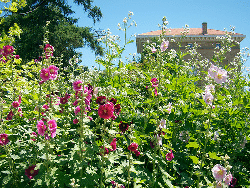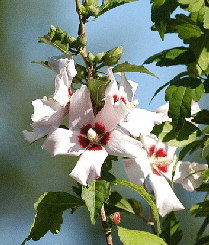Alcea Rosea Hollyhocks
Alcea rosea syn. Althaea rosea
Common Name: Hollyhock
Plant Type: Biennial
Height: 6-8 feet
Spread: 1-2 feet
Sun/Shade Requirements: Full sun
Water Requirements: Average, water well then allow to dry out.
Soil Requirements: Average well drained soil. Not fussy about pH.
Growth Habit: Tall upright
Bloom Time: June to August
Bloom Color: Multiple colors
Bloom Form: Large, simple, cup shaped blooms in single form. Double blooms are full and heavily ruffled.
Foliage: Large heart shaped leaves of dark green, progressively smaller toward the top of the spire.
Fragrance: None noted.
Pest and Disease Resistance: Resists rabbits, tolerate Black Walnut. Foliage is susceptible to rust,leaf spot and anthracnose. May be afflicted with spider mites and Japanese beetles.
Fertilize: Apply a balanced liquid fertilizer diluted to half strength every week or two.
Maintenance: Deadheading may prolong the bloom season, but will reduce self seeding. Sow seeds in April to May or August to September. Divide only after flowering.
Other: Attracts hummingbirds and butterflies. Will naturalize
Hardiness: Zones 3-10
Most hollyhocks are actually self seeding biennials rather than a true perennial, so they should be grown in an informal bed where precise placement is irrelevant. They are easy to cultivate and have a two year life cycle. The first season only foliage is produced, the second season blooms are produced and they die with a frost. The self seeding and continuous plant production allows them to exist essentially as a perennial. Towering spikes are strong and rigid, reaching as much as 8 feet tall. Staking is not generally necessary unless they are grown in open areas exposed to wind and storms. During autumn, next year’s plants will appear, so be cautious when cleaning out the garden.
These hardy, old fashioned, striking plants seem to have fallen from favor in the modern garden. But the introduction of true perennial hollyhocks may renew interest. Hollyhocks are prolific bloomers all summer. They prefer well drained neutral soil and will not tolerate wet winter soil. The 5-8 foot plants are best grown along a high fence or in a protected location so they don’t need to be staked. Some are hardy to zone 2.
Biennial hollyhocks are available in a vast variety of colors including brown purple called ‘Nigra’, single or double blooms, multi color or variegated. Dwarf varieties are available that reach only about 3 feet tall.



